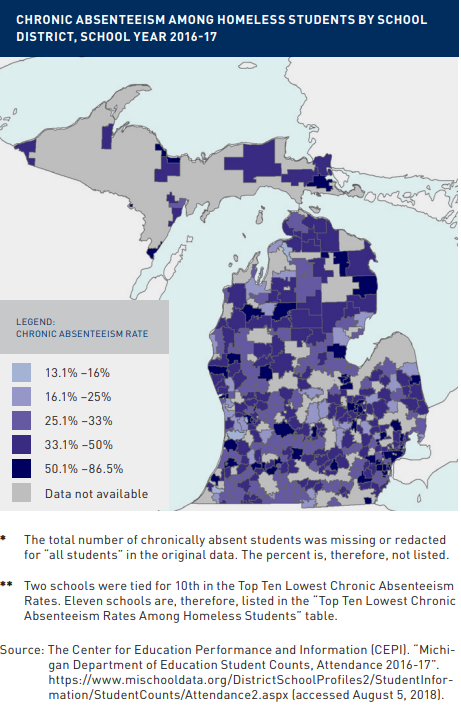Missing School, Missing a Home
Download PDF of full policy brief
By Jennifer Erb-Downward and Payton Watt
Introduction
Attendance is vital to academic success but many children in Michigan are not making it to school. Based on recent estimates, Michigan has the sixth highest statewide chronic absenteeism rate in the country. Close to one out of every six children enrolled in the state’s public and charter schools were chronically absent in school year 2016-17, missing 10% or more of school days. This is cause for alarm for Michigan policymakers, educators and families. Chronically absent students are less likely to meet grade level proficiency standards and are more likely to dropout of school than their peers, with impacts seen as early as preschool. These effects can be lasting. Among third grade students, those who were not chronically absent in kindergarten and first grade were three-and-a-half times more likely to read on grade level than their peers who were chronically absent both years (64% vs. 17% respectively). The passage of Michigan’s third-grade reading law, which mandates retention of students who are a grade or more behind in reading, makes these statistics even more pressing. If Michigan is to achieve its goal of becoming a top ten education state in the next decade, addressing its high rates of chronic absenteeism will be critical.
Efforts to reduce school absences can be strengthened by understanding the characteristics of students most at risk. Race, income and disability status are all associated with elevated rates of chronic absenteeism, but one group stands out in particular: homeless students. Data shows homelessness is a statewide issue affecting rural, suburban and urban communities alike, which indicates the need for a greater focus on the educational impact of housing instability in Michigan. This brief uses data from the Center for Educational Performance and Information (CEPI) to explore chronic absenteeism and makes policy recommendations to ensure all of the state’s children make it to school.
Key Findings 
- Chronic absenteeism is a statewide issue affecting the education of Michigan’s school children. Roughly one out of every six children (16%) in Michigan was chronically absent in school year 2016-17, and all regions of the state had districts with chronic absenteeism rates of 25% or more.
- Students struggling with economic instability are much more likely to be chronically absent from school than their higher-income peers. Economically disadvantaged students were chronically absent at three times the rate of their higher-income peers (24% and 8% respectively).
- Disparities in chronic absenteeism in Michigan are also prominent based on race and disability status. Close to one-third (32%) of African American students were chronically absent. Likewise, students with disabilities also faced significant challenges—roughly one-quarter (24%) were chronically absent from school.
- Homeless students have the highest chronic absenteeism rate of any group in Michigan for which data is available. Forty percent of homeless students were chronically absent in school year 2016-17, a rate two-and-a-half the statewide average and eight percentage points higher than the next highest category reported (African American students).
Policy Recommendations
- Ensure that attendance programs and policies meet the needs of all students, including those experiencing housing and economic instability. Given the stark differences that exist in chronic absenteeism rates by the level of housing and economic instability a child faces, it is critical that programs to improve attendance are designed in ways that address barriers specific to children and families facing these challenges.
- Learn from successful attendance interventions both within the state and nationally. While chronic absenteeism data for Michigan shows an overall need for improvement in attendance among students, it also highlights areas of success. Many school districts have already implemented successful attendance programs in their districts. These districts are a valuable asset to the state as a whole, and can share what they have learned about reducing chronic absenteeism. Likewise, there are many national examples of successful attendance programs which can serve as models for Michigan.
- Opt into MiDataHub. MiDataHub is a statewide initiative to improve the management and usability of school data. Opting into the initiative provides schools with streamlined access to previously disconnected sources of data which enables improved identification and outreach to struggling students. Presently, only 60% of Michigan school districts have signed up to participate in MiDataHub. Efforts are underway to increase awareness of the free program and to encourage universal participation. School districts can opt into the program via https://midatahub.com/getting-started/district-application-information/.
- Adopt real-time attendance tracking tools at schools statewide. Early identification and outreach to students and families is vital for improving school attendance. It is easy, however, to miss early patterns of school absence that place students at risk for chronic absenteeism. Real-time attendance tracking tools make earlier identification easier, and are available to both teachers and administrators for free through MiDataHub and organizations such as Attendance Works.
- Use available data to identify and prioritize school districts with the greatest need. Geographically visualized and interactive data on chronic absenteeism at the school district (and sometimes school) level is now available publicly and can be a valuable tool for state and local planning. Data broken out by race/ethnicity and disability status can be found at The Hamilton Project: Chronic Absence Across the United States. Data broken out by housing and economic stability in Michigan can be found at Mapping the Impact of Housing and Economic Instability on Chronic Absenteeism in the State of Michigan.
